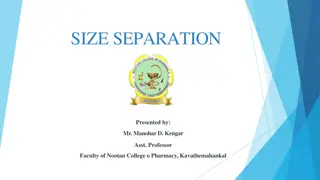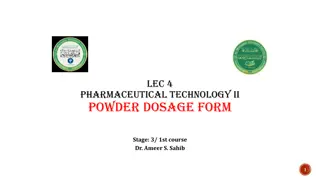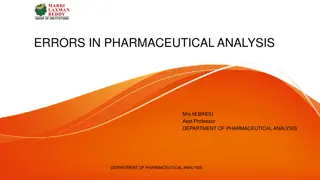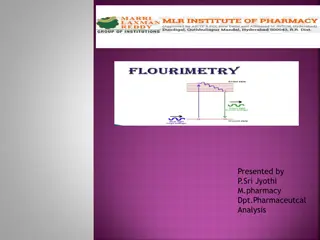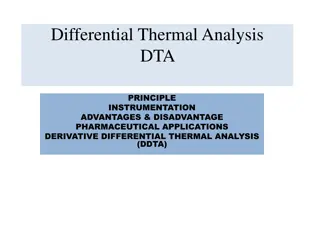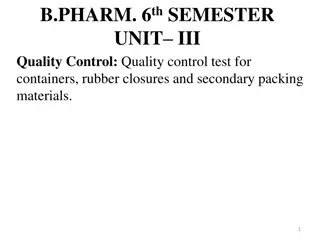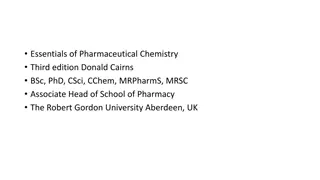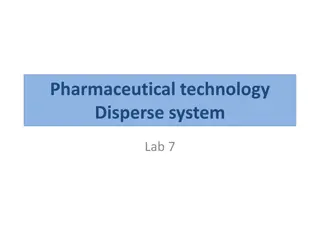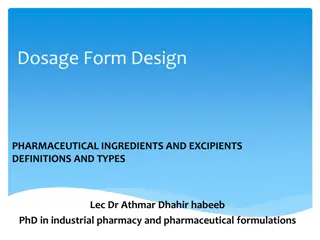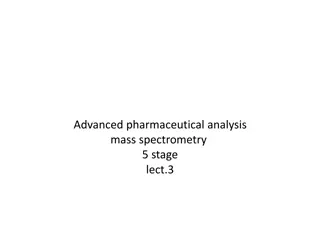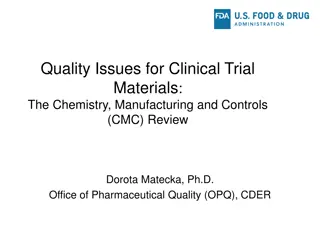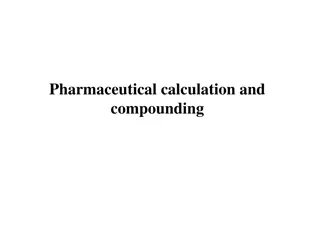Understanding Pharmaceutical Technology Incompatibilities
Pharmaceutical incompatibilities can lead to issues during compounding, dispensing, or administration of drugs. They are classified into physical, chemical, and therapeutic types, with potential delays or reduction in therapeutic effectiveness. Physical incompatibilities may involve insolubility or precipitation, requiring specific measures for correction. Examples include insolubility of silicon in water and precipitation of camphor from aromatic waters. Recognizing and addressing incompatibilities is crucial to ensuring the quality and effectiveness of pharmaceutical products.
- Pharmaceutical technology
- Incompatibilities
- Physical incompatibility
- Chemical incompatibility
- Therapeutic effectiveness
Download Presentation

Please find below an Image/Link to download the presentation.
The content on the website is provided AS IS for your information and personal use only. It may not be sold, licensed, or shared on other websites without obtaining consent from the author. Download presentation by click this link. If you encounter any issues during the download, it is possible that the publisher has removed the file from their server.
E N D
Presentation Transcript
PHARMACEUTICAL TECHNOLOGY Incompatibilities
Incompatibilities The term incompatibility may be applied to prescription when certain problems arise during their compounding, dispensing or administration. The problem usually develop or result of using two or more drug substances, but problem may also occur during the use of a single drug. Incompatibilities are easier to be prevented than to be corrected, this will save time, materials and money.
Classification of incompatibilities Pharmaceutical incompatibilities: which is of two general types Physical incompatibility Chemical incompatibility Therapeutic incompatibility 1. A. B. 3. If pharmaceutical incompatibility is not corrected, it may lead to therapeutic incompatibility, i.e., therapeutic effectiveness may be delayed or reduced.
Pharmaceutical incompatibility Pharmaceutical incompatibility is a condition in the formula that will result in an unsatisfactory product. Pharmaceutical incompatibility may be instantaneous or delayed. Most instantaneous incompatibilities are recognised by visible changes as precipitate or effervescence. Complexation and other reactions may occur and not readily visible. Delayed incompatibility need time and may not be visible.
Physical incompatibility Physical incompatibility is a condition in which the ingredients of the prescription can not be combined satisfactory without special measures, because of their physical properties. It is divided into: Insolubility: in this case the solvent may not be sufficient or it is the wrong solvent. The use of heat in this case to increase the solubility is not useful, because the substance may dissolve at high temperature but precipitate on cool. 1.
Examples of insolubility Insolubility of silicon in water. Insolubility of gums in alcohol. Insolubility of resins in water. Insolubility of phenobarbital in water. Correction of this incompatibility Alteration of the solvent used, for example use of alcohol instead of water. Change in the form of ingredients, for example use of sodium phenobarbital instead of phenobarbital. Alteration of the volume of prescription or solvent, as increase the volume of alcohol in elixir, or increase volume of water. In such correction the dose should increased. Suspension formation using suspending agent Addition of complexing agent such as addition of KI to dissolve I2in water. 1. 2. 3. 4. 1. 2. 3. 4. 5.
Physical incompatibility Precipitation: example of such incompatibility salting out of camphor and volatile oils from aromatic waters when a salt is dissolved in the aromatic water. Separation of immiscible liquids: example of this incompatibility oils dissolved in alcohol are separated as a layer when water is added. This can be corrected or solved by using emulsifying agent and emulsion formation. Liquefaction of solid ingredients: this incompatibility occur due to the formation of eutectic mixture, e.g., when aspirin and aminopyrene are present in the prescription. The prescription is corrected by adding light magnesium oxide or magnesium carbonate as adsorbent and diluent. In other cases, physical incompatibility are corrected by Addition or omission of therapeutically inactive substances. Change the dosage form dispensed e.g., instead of solution formation, one can prepare solid dosage form as capsule or packets (aspirin is example of drug that can not be prepared as solution) 2. 3. 4. 1. 2.
Chemical incompatibility Chemical incompatibility usually occur as a result of chemical interaction among ingredients of the prescription. The usual chemical incompatibility occur immediately upon compounding so called immediate incompatibility, are readily apparent due to effervescence, precipitation or color changes, etc. Sometimes chemical incompatibility may delayed and this type may or may not result in loss of therapeutic activity.
Types of chemical incompatibility Oxidation: certain prescription mixtures may be oxidized if exposed to air, excessive storage temperature, light, over dilution, incorrect pH adjustment or presence of catalysts like heavy metal ions as (Fe+3, Fe+2, Cu+2, Cr+3---) also the bacterial or mold enzymes. examples: Compounds undergo oxidation by heat, e.g., adrenalin, phenyl ephrine and dextrose. Compounds undergo oxidation by light and catalysts, e.g., sulfacetamide eye drop, sulfonamide injection. Compounds undergo auto-oxidation, e.g., oils and fats, phenolic substances, aldehydes and vitamins. They are sometimes used as antioxidant themselves. 1. 1. 2. 3.
Types of chemical incompatibility Reduction: it is less common in prescriptions although silver salts may be reduced by light to metallic form. Racemization: the conversion of an optically active form to optically inactive form without changing the chemical composition. This usually produced pharmacological activity. Examples: adrenaline, dextroamphetamine. Precipitation: when two or more pharmaceuticals are combined, a chemical change may take place with the formation of an insoluble substance which precipitate from solution. Flocculent precipitation which develop several days after prescription is prepared may be due to delayed incompatibility, but more frequently are evidence of growth of yeast, mold, or bacteria. Such growth may be due to indirectly to a chemical incompatibility, if preservation system is inactivated by chemical reaction. 2. 3. 4.
Types of chemical incompatibility Evolution of a gas: a gas may be formed by a chemical reaction between ingredients. Examples are the effervescence caused by the liberation of CO2 from 1- the reaction of carbonate and acids in aqueous media. 2- decomposition of syrups of para- amino salicylic acid. Gelatinization: sol may form a gel when combined with certain substances. Examples: acacia sol are gelatinized by ferric salts since acacia possesses carboxyl group which may be cross-linked by trivalent ferric ions to form cross-linked polymer chin. 5. 6.
Types of chemical incompatibility Precipitation due to increase or decrease the pH. Examples: morphine hydrochloride and other alkaloidal compounds are weak base so soluble in acidic media and precipitate in basic media. Alkaloid also precipitate in presence in presence of tannins. Tannins are found in cardamon, hamamelis, cinchona, cinnamon and tea. So for poisoning with alkaloid we use tea in high concentration to precipitate alkaloid and prevent its absorption. Iron salt is precipitate in presence of tannic acid, the precipitate is dark in color depending on the amount of tannic acid present. 7.
The following Rxs have chemical incompatibility Rx1 Ammonium carbonate or bicarbonate Oxymel Water Incompatibility: formation of gas CO2 due to acid-base reaction. Since oxymel is weak acid due to acetic acid present in it. Oxymel is a combination of honey and acetic acid. Correction: this problem can be solved by controlling the reaction during mixing, as using open container until a reaction stopped or finished.
Rx2 Sodium salicylate 5 gm Syrup of lemon 20 ml Water Q.S to 75 ml Incompatibility: one of the component of syrup lemon is citric acid and this will convert sodium salicylate to salicylic acid, due to decrease the pH and salicylic acid has low solubility in water so it will precipitate. Correction: to prevent this we use Tr. Of lemon with simple syrup instead of syrup lemon or we change the syrup to suspension using suspending agent. Other examples: 1- precipitation of barbituric acid from its salt solution in presence of acid or any preparation containing acid like syrup glycerophosphate. 2. Sulphacetamide sodium eye drop is salt of weak acid and precipitate in acidic media forming free acid.
Therapeutic incompatibility Therapeutic incompatibility may occur in as: an over dose or improper dose of single drug e.g., the infant take 125 mg antibiotic while children and adult should take 250 mg; or higher dose 500 mg for adult, so we should not give the adult dose to the infant. Also Tetracycline may precipitate in the teeth causing a discoloration, so should not give this antibiotic for children under 8 years old. As an additive combination of two drugs As an antagonist combination of two drugs Prescribing wrong drug. Contraindicated drug. Adverse drug reaction. 1. 2. 3. 4. 5. 6.






